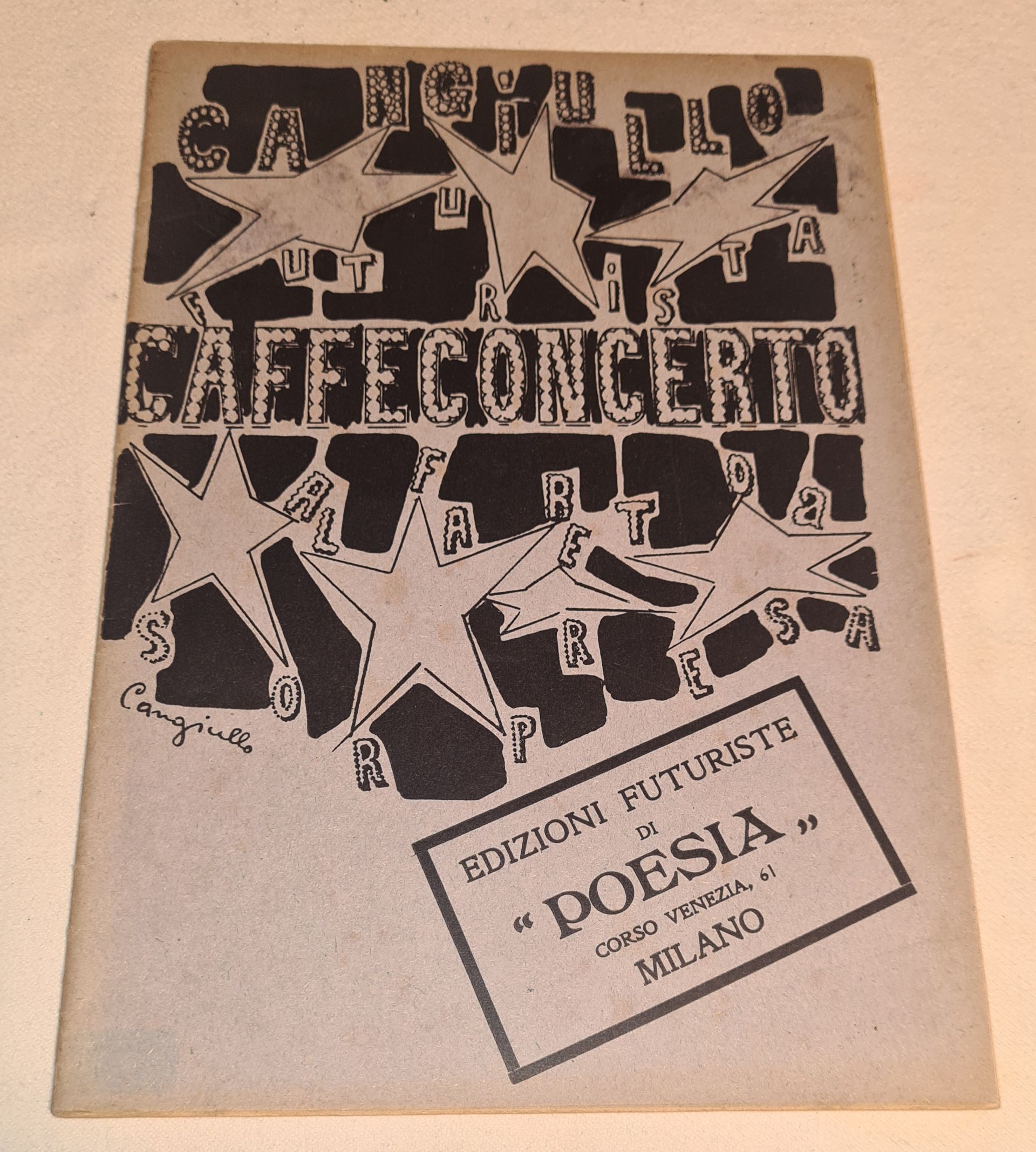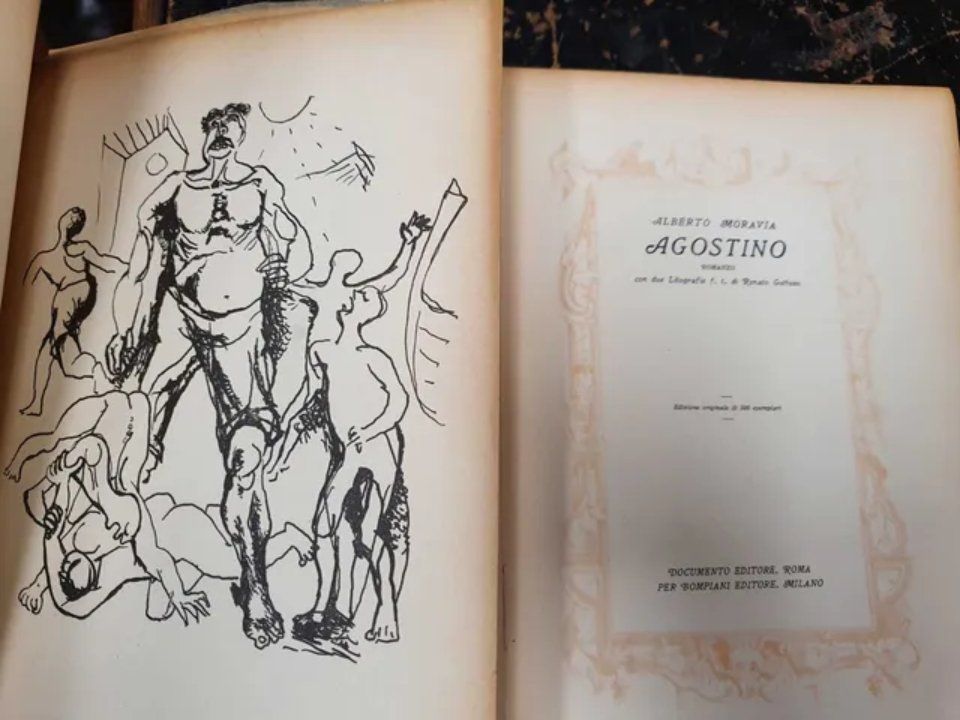Italian Literature of the 20th Century
Café Concerto. Surprise Alphabet. 1919.
Author: CANGIULLO, FRANCESCO

Specimen in excellent condition.
Original edition entirely illustrated and parolibera, printed on paper of different colours. Book composed as if it were a variety show, with an introductory set of fake advertising posters, programme divided into first and second parts for a total of 16 moments, drawn through an unscrupulous paroliberalism, in which the letters are distorted to outline figures and profiles. See Salaris, Storia, p. 106; Hulten, Futurismo & futurismi, p. 439; Cammarota, Futurismo, 76.14.
Francesco Cangiullo (Naples, 1884 - Livorno, 1977) joined the Futurist movement, of which he became one of the major exponents, in 1905, on the occasion of an "evening" at the Mercadante organised for the arrival of Marinetti, Palazzeschi, Altomare, Mazza and the painters Boccioni, Carrà and Russolo.
Creator of free-word experiments, visual and sound dynamics (from humanised letters to the surprise alphabet), he published his first futurist work "Le Cocottesche" in 1912, followed by Caffè Concerto (1919), Poesia Pentagrammata (1923) and the collaboration with the futurist magazine "Lacerba" (1913 - 1915).
Cangiullo signed with Marinetti the "Manifesto of the Theatre of Surprise" (magazine "Il futurismo" January 1922) whose project he attempted to realise and spread during the tour with the theatre company of R. De Angelis.
These experiences were then recalled in the volume "Novelle del varietà" (1938). The gradual return to a more traditional poetry and the slow detachment from futurism were narrated in two of his last works "Serate futuriste" (1930) and "Poesia innamorata" (1943), a synthesis of his poetic production after 1919.
Manifestos of Futurism
Author: Marinetti
Publisher: Istituto editoriale italiano, sd (1919) 4 volumes, full leather binding, with dust jacket.

Perfect condition. Extremely rare. During its stay in the artistic field, the futurist avant-garde became the promoter of various manifestos, if in fact in 1909 Filippo Tommaso Marinetti published in the French magazine “Le Figarò” the official edition of the new avant-garde, the following years saw the introduction of other manifestos written by other members of the group, especially in the first decade of the group's life, commonly considered the most fruitful. The manifesto therefore became for the futurists the main way to communicate their ideas and their cultural action, later inspiring also the other avant-gardes that were beginning to spread throughout the European continent, however it still belongs to Marinetti the ability and merit of having been able to confer the manifesto the dignity to be considered a true literary genre. In particular, there were three collections of futurist manifestos: 1. The first in Florence in 1914 with “The Manifestos of Futurism” with an edition by Lacerba; 2. The second in Milan in 1917 with “Noi futuristi” with Riccardo Quintieri Editore; 3. The third and last in Milan in 1919 with “I manifestoi del Futurismo” with the Istituto editoriale italiano, this collection in particular was divided into four volumes for a total of fifty-nine documents, obviously written and edited by different members of the group even if Marinetti always remained the main hand and voice; In addition to the manifestos, whose main objective was to establish for their group and expose for readers the rules and techniques necessary for the new artistic languages of literature, painting, sculpture, architecture, music, theatre and cinema, there were also other documents that expressed themselves on secondary themes such as food (they invented a mess of different types of meat and cheese), clothing, fashion (dictated for them however by purely geometric and rational lines), war, machines and modernity in general, all however flowing into a political panorama. Even though all these posters focused on completely different themes and discussed apparently irreconcilable issues, it is easy to perceive a style, a unified and recognisable spirit, typical of the Italian futuristic avant-garde. This unified spirit is particularly evident and perceptible in the application of the same basic principles of their ideology, always following a style that can always be considered polemical, scandalous and peremptory.
Unlike other avant-gardes of the time, which tended to focus by definition on and intervene in all strictly cultural and artistic fields, Futurism distanced itself.
Agostino
Original edition of 500 copies
Author: Alberto Moravia
Publisher: Documento Editore for Bompiani Editore Milan, Rome, 1944.

Editorial binding in mz. cloth and cardboard with a small engraving by Luigi Bartolini. Fourth volume of La Margherita edited by Federigo Valli. Blind editorial stamp on the title page and on the lithographs. Original edition of Moravia's work in excellent condition.
With two lithographs by Renato Guttuso.
LOCATION
Via Piè di Marmo, 27
00186 - Roma
RECIPIENTS
P.I. 11986191002 | Legal information | Privacy and Cookie Policy










